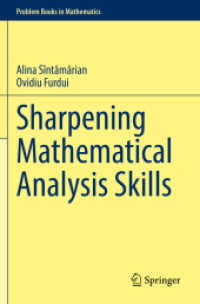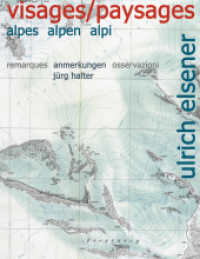- ホーム
- > 洋書
- > ドイツ書
- > Mathematics, Sciences & Technology
- > Technology
- > electronics, electrical engineering, telecommunications
Full Description
Intelligent electromechanical systems (SEMS) are used in cyber-physical systems that have the ability to integrate computing, transmission and storage of information, monitoring and management of objects of the physical world. Modern intelligent robots are created based on CMS modules. A distinctive feature of SEMS is the presence of a central nervous system (CNS) similar to a human one. The Central Nervous System ensures that decisions about appropriate behavior are made in accordance with the goals of SEMS based on rational knowledge about the environment in which it operates, and in accordance with its own technical and mental state. For the Central nervous system, the extraction and processing of this external information by the central nervous system is an integral part of the process of forming their situational control systems. Moreover, in order for SEMS to act expediently in a changing and unfamiliar environment and without human participation, it is necessary to endow them with properties similar to the mental properties of animals, since emotions and temperament are among the main assessments of the behavior of highly organized organisms. Therefore, it is quite natural to take into account the influence of emotions on decision-making in conditions of incomplete information about the environment, especially when SEMS interacts with a person to perform complex technological operations.. Despite the existing technical difficulties, a significant number of mathematical and software tools have accumulated to date, providing the CNS SEMS with the ability to take into account the psyche when interacting with a person. Limitations of sensory capabilities and computing power should be attributed to the limited cognitive abilities of artificial intelligence. These features of the central nervous system of modern SEMS must be taken into account when creating mathematical and software tools for SEMS information and measurement systems, for the formation of databasesand knowledge, for recognition and classification, decision-making and the formation of control actions.
Contents
.- Part 1: SEMS information and measurement systems.
.- 1.1. The accuracy research of the exposed incremental encoder based on image formation method for SEMS applications (Vladimir N. Kuznetsov, Ayur T. Garmaev, Ivan G. Deyneka, Aleksandr S. Vasilev).
.- 1.2. Intelligent support for selecting sensors for information measurement systems (Irina A. Koptelova, Lyudmila A. Konovalova).
.- 1.3. Intelligent information-measuring system for relay protection of overhead power lines with adaptation to external factors (Alexey .A. Shilin, Pavel V. Dikarev, Danila N. Avdeyuk).
.- 1.4. Intelligent information-measuring system for controlling the operating mode of hydroelectric power plants (Alexander N. Shilin, Lyudmila A. Konovalova, Muluken. A. Bogale).
.- Part 2: Formation and Analysis of Databases and Knowledge.
.- 2.1. Creation of databases and formalization of knowledge using identification of SEMS, working under various constrains (Andrey Yu. Kuchmin).
.- 2.2. New methods for recognizing and resolving contradictions in knowledge (Boris A. Kulik, Alexander Ya. Fridman).
.- 2.3. Intellectual model of mobile robots coalitions formation in network-centric group control systems (Vladimir A. Serov, Evgeny M. Voronov, Yulia Yu. Kurilenko).
.- 2.4. Design Ontology for Situational Digital Twins in Modeling Structural Safety within a Group of Intelligent Robots (Alexander Ya. Fridman).
.- Part 3: Recognition and Classification.
.- 3.1. Acoustic energy mapping method for acousto-optical non-destructive testing system with automated positioning (Akhmerov A.Kh., Sycheva S.D., Khodzhimukhamedov O.I., Deyneka I.G., Vasilev A.S., Kulikov A.V.).
.- 3.2. Analysis of the Degree of Differentiation Biological Tissues for Diagnosis of Pathological Processes Using Robotic Spectral Complexes (Ruslan D. Khlynov, Victoria A. Ryzhova, Ekaterina A. Tsygankova, Igor A. Konyakhin, Valery V. Korotaev, Sergey N. Yarishev, Todor S. Djamiykov, Marin B. Marinov).
.- 3.3. Structure of a model of situational control for intelligent robots containing SEMS knowledge bases, by means of coordinating contexts of a specialized language of their communication (Alexander Ya. Fridman, Boris A. Kulik).
.- 3.4. Identification of the SEMS module using the example of a model of a linear electric drive of a counter-reflector actuator taking into account constrains (Andrey Yu. Kuchmin).
.- Part 4: Decision-making.
.- 4.1. Adaptive algorithms for evaluating the effect of microdynamics on crystal growth parameters in the information-control technological module of SEMS in microgravity (Sergey N. Sayapin).
.- 4.2. Model Predictive Control and Genetic Algorithms for Optimization of Continuous Stirred Tank Reactors (Ali Deeb, Vladimir N. Khokhlovskiy, Viacheslav P. Shkodyrev).
.- 4.3. Decision-making when assessing financing risks using the logical and linguistic method. (Andrey E. Gorodetskiy, Irina L. Tarasova, Anna R. Krasavtseva).
.- 4.4. Risk analysis of project financing using the logical-linguistic classification method (Andrey E. Gorodetskiy, Anna R. Krasavtseva, Irina L. Tarasova).
.- Part 5: Formation of control actions.
.- 5.1. Forming an emotional response in a robot (Viacheslav V. Kozlov).
.- 5.2. Autocollimation system with extended distance for angular rotation measurements in SEMS applications (Mikhail M. Nikitin, Igor A. Konyakhin).
.- 5.3. Polarization Imaging of Pathological Biological Tissues Using a Robotic System Based on Multi-Element Sensors (Ruslan D. Khlynov, Victoria A. Ryzhova, Ekaterina A. Tsygankova, Artemii Y. Zhdanov, Igor A. Konyakhin, Valery V. Korotaev, Sergey N. Yarishev, Todor S. Djamiykov, Marin B. Marinov).
.- 5.4. Comparative Analysis of Methods for Classifying Electroencephalography Signals for a Robotic Brain-Computer Interface (Artemii Y. Zhdanov, Victoria A. Ryzhova, Ruslan D. Khlynov, Igor A. Konyakhin, Yuri E. Shelepin).








